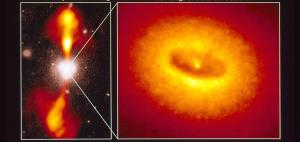Blog
Yes, Virginia,
There Are Black Holes
25 September 2014
 NASA/ H. Ford
NASA/ H. FordRecent headlines have proclaimed “Black Holes Don’t Exist!” They’re wrong. Black holes absolutely exist. We know this observationally. We know by the orbits of stars in the center of our galaxy that there is a supermassive black hole in its center. We know of binary black hole systems. We’ve found the infrared signatures of more than a million black holes. We know of stellar mass black holes, and intermediate mass black holes. We can even see a gas cloud ripped apart by the intense gravity of a black hole. And we can take images of black holes, such as the one above. Yes, Virginia, there are black holes.
So what’s with the headlines? It seems to start with a link-bait article about a new work concerning the formation of stellar mass black holes.1 The paper hasn’t been peer reviewed, but it is an extension of an earlier work by the same authors that has been peer reviewed.2 The focus of both of these papers is on the firewall paradox, specifically how Hawking radiation might affect the gravitational collapse of a star to form a black hole.
The firewall paradox is something that arises when you try to combine black holes with quantum theory. In quantum theory there are limits to what can be known about an object. For example, you cannot know an object’s exact energy. Because of this uncertainty, the energy of a system can fluctuate spontaneously, so long as its average remains constant. In 1974 Stephen Hawking demonstrated is that near the event horizon of a black hole pairs of particles can appear, where one particle becomes trapped within the event horizon (reducing the black holes mass slightly) while the other can escape as radiation (carrying away a bit of the black hole’s energy). These escaping particles have come to be known as Hawking radiation.
According to general relativity, if you were to fall into a black hole, you shouldn’t notice anything strange when you cross the event horizon. Yes, you might feel strong tidal forces, but you’d feel those outside the black hole as well. But according to quantum theory if all this Hawking radiation is being created near the event horizon, then you should experience a firewall of quantum particles. The solution to this theoretical problem is still a matter of some debate. Some, such as Hawking and the authors of this new paper, feel that the Hawking firewall prevents black hole horizons from forming. Others, such as Sabine Hossenfelder argue that quantum theory doesn’t lead to a Hawking firewall. Just to be clear, I’m personally in the Hossenfelder camp.
In this new paper, the authors show that if the Hawking firewall idea is correct, then as a star starts collapsing at the end of its life, before it collapses into a black hole Hawking radiation starts kicking in, which pushes back against the collapsing star. So instead of collapsing into a solar-mass black hole, the star almost collapses into a black hole, Hawking radiation stops its collapse, and the stellar core then explodes. So the star dies in a supernova explosion, but no black hole is formed from its core.
This is interesting theoretical work, and it raises questions about the formation of stellar-mass black holes. But it doesn’t prove that stellar-mass black holes don’t exist, nor does it say anything about intermediate mass or supermassive black holes, which would form by processes other than stellar collapse. And of course the work depends upon Hawking’s take on firewalls to be correct, which hasn’t been proven. To say that this work proves black holes don’t exist is disingenuous at best.
So don’t buy into the hype. Black holes are real, this work is interesting, and the link-baiters should be ashamed of themselves.
Mersini-Houghton, L., and H. P. Pfeiffer. “Back-reaction of the Hawking radiation flux on a gravitationally collapsing star II: Fireworks instead of firewalls e-Print.” arXiv preprint arXiv:1409.1837 (2014). ↩︎
Mersini-Houghton, Laura. “Backreaction of Hawking radiation on a gravitationally collapsing star I: Black holes?.” Physics Letters B 738 (2014): 61-67. ↩︎